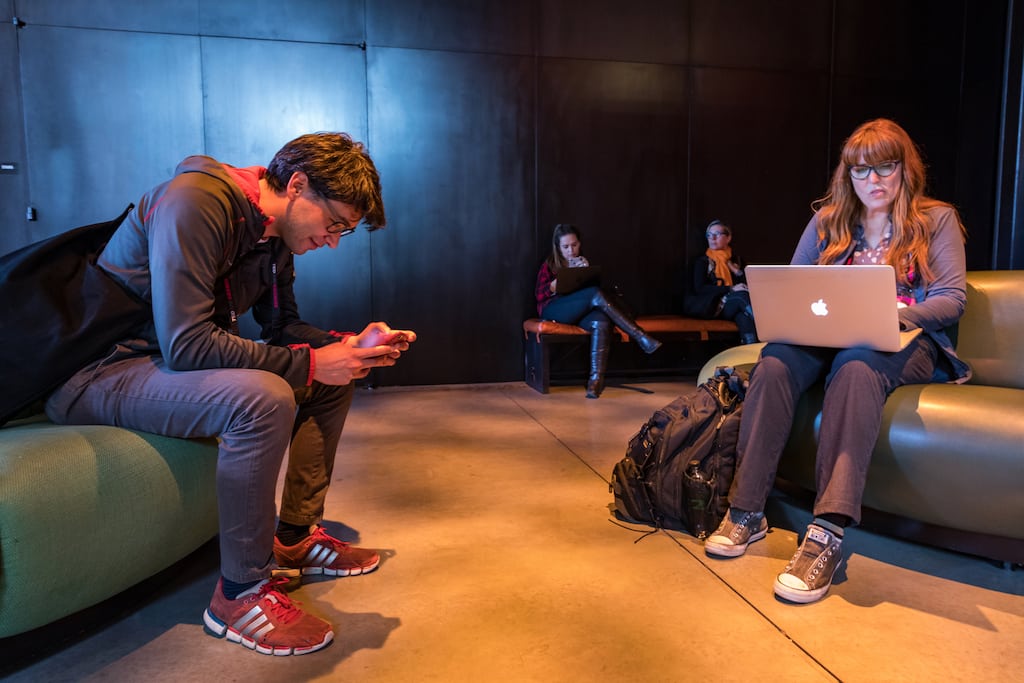Skift Take
The growth of mobile meeting apps presents planners with a dilemma filled with irony. Are the apps — aimed at facilitating and enhancing the meeting experience — actually diminishing the kind of face-to-face interactions that are the very purpose of on-site events?
It’s now the most familiar of sights: Heads down—staring at their devices—just about everyone is talking, texting, emailing, or posting online countless times a day.
It’s no different at meetings and conferences. At events, personal devices combine with ubiquitous meeting apps to siphon off attendee engagement and impact their face-to-face interactions.
Or do they? The answer from meeting planners and tech providers is a definite…maybe.
Some view meeting apps and personal devices as distractions that defeat the very purpose of on-site meetings. Others say that they can be a force for promoting engagement and networking.
Jared Bodnar, vice president of marketing for Attendify, thinks mobile event apps can actually increase face-to-face interactions if promoted and used correctly.
“The reason is simple; people are accustomed to using their mobile phones,” Bodnar said. “We all know how awkward it is to walk up to a stranger and strike up a conversation at a networking event.
“In-app direct messages help break the ice by enabling attendees to connect with people on their mobile devices first, then set up a time to meet in person later. Many attendees interact on the event app one-on-one and then meet up to grab a coffee or cocktail after the next session, which provides a much more comfortable experience for the attendees.”
There’s a huge — and growing—range of meeting apps though, and planners’ experiences with them are tied to the type of app and how it’s used.
“I think it’s really fun to use audience survey apps during the session – it keeps attendees engaged and it’s beneficial for them to see the results,” said Linda Nelson, president and CEO of To Plan Ahead, an event management company. “Other than that, I don’t support using apps that detract from what is being said by the speaker, for instance posting comments and pictures. It’s way too distracting and frustrating and the audience ends up feeling like they’ve missed the point of the session.”
Nelson has also tried using social interaction and gamification through on-site apps without much success.
Bodnar, however, said clients have done “some really nifty things” with gamification, rendering the event app more natural and seamless rather than distracting.
“Instead of creating a clunky scavenger hunt or bingo card, our gamification is based on what people are already doing in the app,” he said. “The more photos they post, comments they make, and likes they give to other posts, the higher they score on the event app leaderboard. Instead of taking them out of the event, this immerses them in it.”
Planners are finding varying degrees of success with mobile apps, according to Brent Rogers, vice president of digital services for PSAV. “I have seen everything from great successes to mediocre implementations of new technologies,” he said.
Rogers believes the meeting apps themselves are not to blame for digital distraction.
“The event technology is not the distraction, it is the non-event technology,” he said. “If the attendee is not engaged, email and social media will win. The event technology needs to be used to engage and move the attendee from a passive observer to an active participant.
“If attendees are thinking about their personal email and social media accounts, I don’t consider those to be distractions as much as I would consider it a failure to be engaged.
Attendees’ involvement with their email and social media can also be an issue.
“There are two schools of thought on this,” said Nelson. “If attendees feel they cannot check their email, they may not attend. However, it’s also a distraction so I tend to suggest up-front that they turn off their cell phones and turn their attention to what is being said in the room; I suggest that they will find the experience to be far more rewarding.”
Personal devices, of course, and mobile apps are here to stay regardless of potential distractions.
“There is no going back from going digital when you need to put information in the attendees’ hands,” Rogers said. “Printed materials are no longer acceptable. When looking at ways to participate in a session, using a mobile device is the most comfortable way to do so for the majority of participants.”
Have a confidential tip for Skift? Get in touch
Tags: event technology, meetings, meetingsiq
Photo credit: Attendees at TED2018 The Age of Amazement in Brooklyn, N.Y. Planners are figuring out novel ways to use apps without distraction from the actual event they're putting on. Dian Lofton / TED / Flickr
